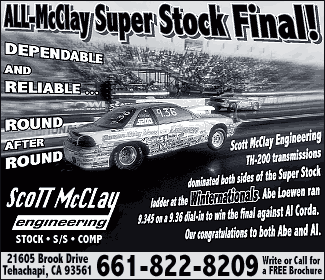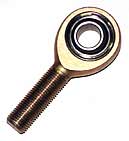
That’s the rudiments, but there’s
more. When shopping for rod ends for your race
car, you’ll often come across “commercial”
or economy models. Although there are a number
of different economy rod ends available (that’s
where most of the Far East imports come into
play), the only type you should even think about
for a serious application are the fully swaged,
two-piece models. On these rod ends, the body
is formed (or “swaged”) around the
ball so that the race the ball rides on is actually
part of the body. When looking at inexpensive
rod ends, this is the only type that offers
decent radial or pull strength coupled with
good axial strength (axial strength is the resistance
of the ball being pushed out of the side of
the body).
Real rod ends use a three-piece precision design.
In this application, the race is formed around
the ball and then the race insert is staked
into the body. Why is this important? Simple.
This type of construction offers a much closer
fit along with a much higher degree of precision
between the ball and the race. Quite often,
this three-piece configuration is called an
“aircraft” rod end. The three-piece
design allows different materials to be incorporated
during the construction process. In turn, this
allows the rod end to best match the application.
Races can be made of mild, alloy or stainless
steel (brass or aluminum bronze is sometimes
used, but should be avoided because of its low
strength) and bodies are made in mild, alloy,
stainless steel, aluminum or even titanium.
Teflon Lubrication …
Another common option on rod ends is a Teflon
liner. This allows the rod end to be self-lubricating.
This is important, since it’s usually difficult
(if not impossible) to grease or oil a rod end
once it’s installed on a car. But more
important is the fact that grease fittings can
physically weaken the rod end (a good comparison
is a common universal joint with a
ADVERTISEMENT
 |
grease
fitting—so called “lubable” joints
are far more fragile than solid examples). Of
course, grease on the rod end ball also attracts
grit, which works its way between the ball and
race, actually accelerating wear.
A Teflon liner eliminates most, if not all
of these circumstances. By design, a Teflon
liner consists of a carrier component, usually
a fabric (which provides compressive strength)
and a Teflon component for lubricity along with
various bonding resins. The Teflon liner is
bonded to the race so that the ball actually
rides on the liner. The movement of the ball
rubs Teflon on the ball which, in turn, provides
lubrication. Typically you can purchase two
or three-piece rod ends with Teflon liners.
When looking at Teflon-lined rod ends beware
of inexpensive examples with virgin Teflon.
It’s relatively soft (approximately 10,000
pounds PSI compressive strength). Meanwhile,
a high quality composite Teflon liner will have
a compressive strength of somewhere between
40,000 and 60,000 PSI. You’ll also find
that a good Teflon liner eliminates clearance
between the ball and race, which in turn, makes
for a tighter fit.
 This
Aurora rod end has a composite Teflon liner
(usually, you can purchase two or three piece
rod ends with Teflon liners). By design, the
liner consists of a carrier component, usually
a fabric (which provides compressive strength),
a Teflon component for lubricity along with
various bonding resins. The Teflon liner is
bonded to the race so that the ball actually
rides on the liner. The movement of the ball
rubs Teflon on the ball which provides the lubrication. This
Aurora rod end has a composite Teflon liner
(usually, you can purchase two or three piece
rod ends with Teflon liners). By design, the
liner consists of a carrier component, usually
a fabric (which provides compressive strength),
a Teflon component for lubricity along with
various bonding resins. The Teflon liner is
bonded to the race so that the ball actually
rides on the liner. The movement of the ball
rubs Teflon on the ball which provides the lubrication.
Of course, simply adding a Teflon liner to
a rod end doesn’t insure precision or performance.
One term you’ll come across when dealing
with rod ends is “beating out”. What
this refers to are usually a couple of distinct
problems. The first is the deformation of low
strength “self lubricating” liners.
You see, some “econo rod ends” have
races that are constructed with molded plastic
(occasionally mixed with a fiberglass filler).
Teflon may also be added for lubricity. These
units have a compressive strength of no more
than 15,000 PSI. This causes the race to deform
long before the body sees any damage.

|